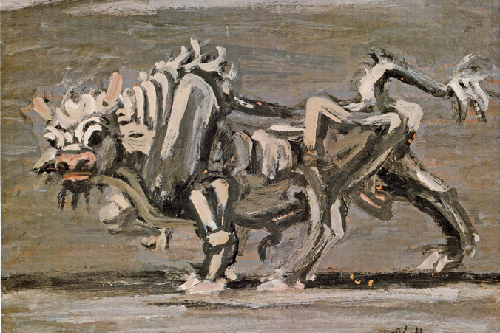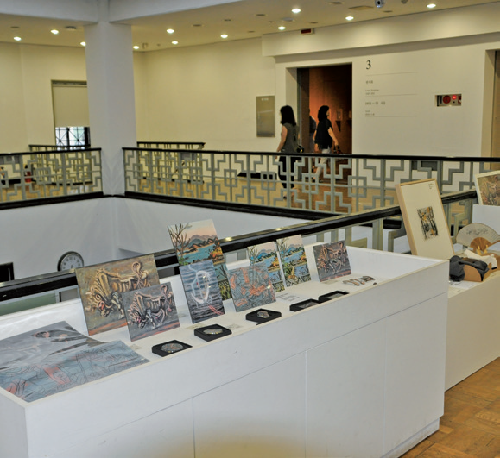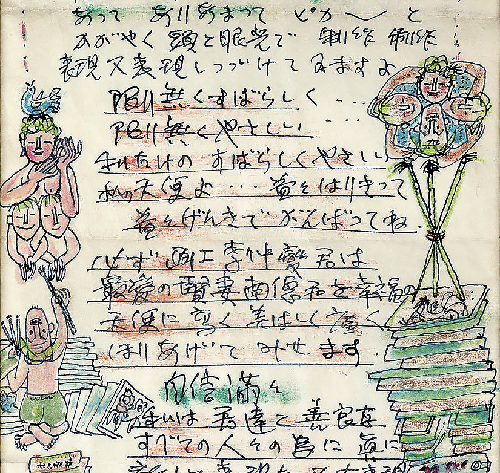
Turn for a moment to the picture on the left. Just as the sun rises, a family starts off on a long journey. The mother and her two sons take wheel that is pulled by a yellow bull. The father pulls the bull. The two sons play with a bird and appear not to have a care in world. Flowers adorn the image, making the work more cheery. Looking at the artwork, people will sense happiness and peace and recognize how much the artist loves art, family, and the nation. The title of this piece is <The Family who Pass Away>, and the artist is Lee JungSeop.

1916-1956, Travel to the Past
Lee JungSeop (1916 to 1956) lived through two wars in Korea. He studied art in Japan during the Japanese colonial era, and after Korea was liberated from Japan, he returned home. However, soon after his return, another war broke out on the peninsula, and he suffered a hard life in Busan and on Jeju Island. Although he was poor, he lived a happy life with a wife and two sons, which is the basis of the art piece featured in this article. Another influence on his work is the inclusion of a bull. The bull was his way of symbolizing nationalism during war. To express humanity’s pain and identity, he drew dynamic and various bull images. He was an honest artist who expressed himself frankly. It is widely known that he suffered from mental illness due to his poor financial situation and living separated from his family.

This exhibition marks the 100th anniversary of the birth of Lee JungSeop. Visitors enjoy a trip back in time as the JungSeop Museum is located inside the ancient Deoksu Palace. The palace creates an environment that makes Lee JungSeop’s artworks more magificient.
The museum is located near to Sookmyung Women’s university. Using the Namyeong line, one only rides the subway until City Hall station. It will take only 20 minutes. The exhibition will run until 3 October, so there is plenty of time to arrange a visit. Additionally, while admissions is 7, 000 won, if you are under 24 years old with valid id, there is a discount of 1,000 won. Moreover, if tickets are purchased online, there is also a discount of 1,000 won. Unfortunately, visitors are not permitted to take pictures in the museum, so it is a good idea to bring along a notebook and pen to record information.

ㅈㅜㅇㅅㅓㅂ’s Art, his Family and Love for the Nation
All artists have created their own personalized signature, and Lee JungSeops’ is ㅈㅜㅇㅅㅓㅂ. His work enables people to get a taste of life during his era. The gallery also features his poetry, which is filled with words like <bull> and remains which he used. Since explantions are provided below each painting, visitors are able to understand his work easily. The exhibition is presented in chronological order, so visitors can see the growth in Lee JungSeop’s life gradually.
In first gallery room, there are pieces from Pyeongwon, Pyeongyang, Jeongju, Tokyo, and Wosan (1916-1950), Seogwipo and Busan (1950-1953), and his postcard paintings. Because his family fed to Busan in 1950 to take refuge from the war, many of his works have been lost. Also, most of his postcard paintings were for his wife, who he had meet studying abroad in Japan. After graduating from univeristy, he continued to paint postcard for his wife. These postcards were his way of expressing his love. He didn‘t write letters, but used his drawings to show his love. His postcards were not done in pale colors like other postcards, but were bright and full of passion.

In the second gallery room, vistors meet Tongyeong (1953-1954) and tinfoil paintings. Tinfoil painting was a new art form that Lee JungSeop developed. Because he was poor, he had to look for alternative material and spaces on which to create work. He used the tinfoil paper from imported cigarettes to express his artistic vision. As with his other work, most of the images on his tinfoil paintings were his sons, his wife, and a bull.

The third section of the exhibit centers on Seoul (1954-1955) and his letter paintings. One of the most interesting works in this section is <The letter for his two sons and wife>. In this letter, he paints himself and his family who smile happily. In the letter he writes, "I really miss and love you. I can’t wait to see you again. Please wait for my return." From his letter, it is clear that Lee JungSeop was a gentle father and husband.
The final gallery room looks at Daegu (1955) and Jeongneung (1956). It is believed that during this period in his life, Lee suffered greatly from a mental illness and anoxia, so he spent most of his time in hospital. <The river that does not flow backward> is his final piece. He passed away in 1956.

100 Years Myth, Lee JungSeop
People who first learn about Lee see him as a romantist and patriot. His love of art, family, and the nation is clearly shown in his work. Even under adversity due to poverty and war, he continued with his passion for art using tinfoil as his outlet. Also, no matter how far he was away from his sons and wife, he continued to use them as muse for his work and sent them continuous letters of love. Although he underwent hard times later in life, he continued to express images of independence through the use of bull imagery. 100 years have passed but people continue to appreciate his love of art, family, and the nation. To join in the appreciation of pure passion, visit the Lee JungSeop Museum.



